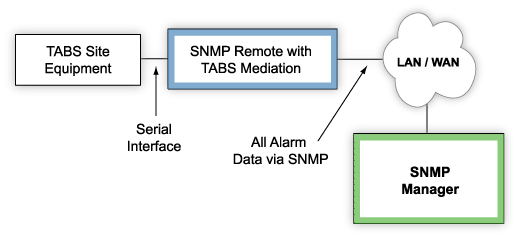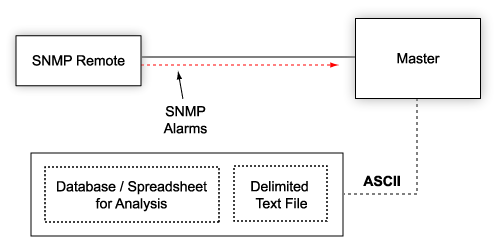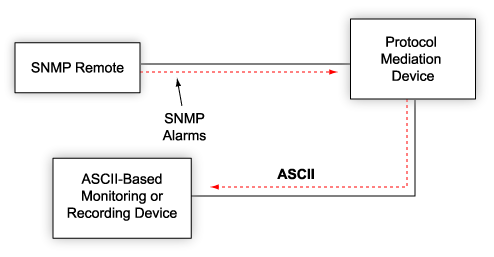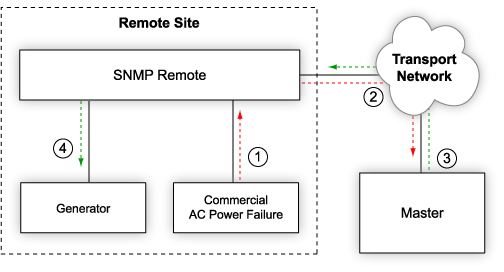Download our free SNMP White Paper. Featuring SNMP Expert Marshall DenHartog.
This guidebook has been created to give you the information you need to successfully implement SNMP-based alarm monitoring in your network.
1-800-693-0351
Have a specific question? Ask our team of expert engineers and get a specific answer!
Sign up for the next DPS Factory Training!

Whether you're new to our equipment or you've used it for years, DPS factory training is the best way to get more from your monitoring.
Reserve Your Seat TodayAre you just learning the SNMP protocol? Do you need to find RTUs and managers with SNMPv3 software? Either way, we can help you. Let's dive into SNMP equipment, tips and protocol guides.
SNMP stands for Simple Network Management Protocol. It is a standard protocol that various devices use to communicate with each other. With the help of SNMP software, SNMP-enabled devices at remote locations (like broadcast antenna towers) can report alarms to your staff, an SNMP manager, or both, before they grow.
In corporate/government IT environments, monitored devices like switches, and even network printers can send SNMP traps (messages) to report status information. Even though SNMP isn't truly "simple" anymore, it has become a popular standard that allows devices from many different manufacturers to communicate with each other.
DPS produces the best SNMP management tools to ensure you're never locked into one manufacturer. We support SNMP in all of our major product lines. That way, you can choose any other SNMP gear you'd like to achieve a "perfect-fit" remote monitoring system in your network. Some companies use our RTUs, some use our master stations, and many use both. All these options integrate with advanced SNMP software for maximum efficiency.
SNMP communication works by exchanging messages between an SNMP manager and SNMP agents on network devices. The SNMP manager sends requests to the agents to retrieve or set information about the device's status and configuration. These requests use standard operations such as GET, SET, and GETNEXT. Strong SNMP software makes these processes more streamlined and secure.
SNMP GETs are used to retrieve information. SETs are sent to change a configuration. SNMP GETNEXT requests are sent to retrieve the next piece of information in the MIB.
The agents respond to these requests by accessing their Management Information Base (MIB) and sending the requested data back to the manager. Additionally, agents can send unsolicited messages known as traps to the manager to notify it of significant events, such as a device failure or threshold breach, enabling proactive network management.
The ability to receive real-time notifications means faster troubleshooting. By getting alerts about significant network events as they happen, you can act promptly to address issues before they escalate into more serious problems. This proactive approach ensures network stability and minimizes downtime.
This simple request-response model, combined with the ability to send alerts, makes SNMP an effective tool for monitoring and managing network devices. With real-time data at your fingertips, you can ensure your network operates smoothly and efficiently.
Network monitoring via SNMP is highly reliable due to its widespread adoption, simplicity, and strength. SNMP software - as well as SNMP's standardized protocol - maintains compatibility across a wide range of network devices. This allows for consistent and accurate monitoring of device statuses and performance metrics.
SNMP's low resource consumption means it can run continuously without significantly impacting network performance. Its ability to generate real-time traps and alerts enables prompt detection and response to network issues. Integrating SNMP software into your monitoring strategy further enhances these capabilities, offering even more insights. However, the reliability of SNMP monitoring can be influenced by factors such as network configuration, the implementation of SNMP agents on devices, and the security measures in place to protect SNMP communications. When properly implemented and secured, SNMP provides a dependable and efficient solution for comprehensive network monitoring and management.
When looking for alternatives to SNMP (Simple Network Management Protocol) monitoring, several options are available. Flow protocols and packet sniffing are common, valued alternatives to SNMP for network monitoring and management.
Flow protocols, like NetFlow or IPFIX, capture detailed information about traffic flows. This information includes the source, destination, volume, and type of traffic. This data provides insights into network usage patterns, security threats, and performance issues. These insights offer a comprehensive view of the network.
Packet sniffing, on the other hand, involves capturing and analyzing individual data packets as they traverse the network. Tools like Wireshark enable deep inspection of packet contents. This deep inspection allows for detailed troubleshooting, performance analysis, and security monitoring. While both methods are powerful tools for advanced network management, they can both be more complex to implement than SNMP.
SNMP is often preferred over flow protocols and packet sniffing for network management due to its simplicity and efficiency. SNMP's straightforward method for monitoring is widely supported by most network hardware. It's ease of implementation and low resource consumption make it ideal for continuous network monitoring. SNMP allows for monitoring without significantly impacting network performance.
Additionally, the ability to generate traps and notifications for specific events makes sure there are timely alerts and automated responses to network issues. This can be more challenging to configure and manage with flow protocols and packet sniffing.
Not all of your gear supports SNMP natively. You have plenty of gear and sensors that report alarms via simple discretes and analogs. You need a real-time SNMP reporting tool like an RTU (Remote Telemetry Unit) to take those inputs and convert them to SNMP traps. If you're working on a defined SNMP network project, you may want to jump directly to the DPS collection of RTUs that support SNMP.
Your SNMP manager is the core of your monitoring system, as they gather all the information from SNMP agents in one single screen. You need to make sure you choose the right one.
Believe it or not, many people are dangerously using free SNMP manager software to manage real-world telecom networks. Freeware is great when you're just learning, but you should never trust an enterprise network to uncontrolled software that doesn't include tech support.
Don't choose an SNMP manager that orphans all of your non-SNMP gear. No matter how modern you think your network is, it probably includes some legacy equipment. Many SNMP managers support SNMP and nothing else. Others can and will handle both traps and alarm messages in other protocols.
The best manager will help you avoid the needless expense and complexity of an external translation box, it should be able to handle SNMP and other protocols.
Another factor in your decision should be the alert methods supported by any potential SNMP manager. If you want your team of 10 technicians to receive individual text messages based on their assigned role, find a manager that supports that function.
Finally, you may find some instances when you need to think smaller about SNMP managers. If you work on a small network (or even a small segment of large network), you may come across cases where you have limited equipment.
It's not enough to justify a large manager. Maybe the site doesn't have LAN (temporarily or permanently). You need some way to monitor your SNMP-capable gear.
The solution is to use a remote SNMP-to-alert device. This will be a small box (about 1 RU) that can send SMS or other alerts when certain pre-programmed SNMP traps are received. This gives you the SNMP visibility you need without requiring LAN to transmit traps.
Don't be stuck with an outdated monitoring tool. Modern managers allow you to manage your SNMP gear with your smartphone.
This is especially useful when your technicians are out in the field. No longer do they have to return to the NOC to get a new assignment. If you have human dispatchers, this is a chance to remove some human error potential from your operations.
It's better to choose a web interface over a dedicated app. An app must be installed, and it may not work with your OS. A web interface will work on most platforms and browsers without installing anything.
You deploy RTUs at your remote facilities to collect alarm data and report it as SNMP traps. There are many different SNMP RTUs, and you shouldn't settle for anything that isn't an excellent fit for your project.
In today's environment, you need to decide whether or not to standardize on an SNMPv3 RTU. Unlike earlier versions of SNMP, v3 resists tampering by using message encryption. At security-conscious organizations (especially government agencies or large corporations), this can render SNMPv1 and SNMPv2c basically obsolete.
Let's assume for a moment that you do have an SNMPv3 mandate. Security mandates don't generally come with budget dollars to replace all your old gear. If you already have SNMP equipment in your network, it probably supports earlier versions of the protocol (v1 and v2c).
That calls for a network management system device that will convert older equipment to secure SNMPv3. The conversion is done locally within a single facility. Unsecured v1 still exists, but it can never leave the building.
Remember one more thing: If you standardize on SNMPv3, you probably also have an enterprise-grade RADIUS server. If you choose an RTU that supports RADIUS login, you can take advantage of the RADIUS profiles you already have.
Let's face it, some of your remote sites don't have the best infrastructure, or even have LAN available. That doesn't mean you have an excuse not to monitor it. One little known but powerful technique is forwarding SNMP via wireless SMS.
All it takes is a conversion device that collects traps locally at each site, and forwards extracted alarm data via wireless SMS text messages (GSM or CDMA).
In this application, an SNMP remote pings IP network managed devices to confirm continued operation. If a device fails to respond to a ping, an alarm is sent as a trap to the manager. This provides immediate notification if vital equipment like servers, routers, and gateways fail or go offline. A remote with ping alarm functionality is essential protection for IP networks.

Ping IP devices to confirm they are still alive.
The same remote can also monitor your legacy telecommunications equipment and environmental conditions at the remote site. Combining many monitoring operations in a single unit, a multi-functional RTU is a practical and cost-effective monitoring solution for an entire site.
Many companies utilize legacy equipment in their networks, such as TABS protocol, which stands for telemetry Asynchronous Block Serial protocol.
While your legacy equipment may still work, it can be difficult to find new equipment that uses the same legacy protocols as your existing equipment. If your devices can not communicate with one another properly, then your system is useless.

Protocol conversion allows TABS site equipment to communicate with SNMP managers by translating TABS to SNMP through an RTU.
The solution is protocol conversion, which is a very simple concept. On-site equipment reporting in TABS protocol is connected via a serial interface to an SNMP remote. The alarm data is translated on-site to SNMP alarm messages (traps) by the remote or RTU and forwarded via LAN to an SNMP manager. The RTU functions as a translator between the legacy equipment and the manager, allowing them to communicate.
Unfortunately, not all remotes are SNMP compatible, and those that are may only be compatible with one version of SNMP. Choosing an RTU that has multi-protocol capabilities is the key.
Protocol conversion allows you to continue to use valuable, functioning legacy equipment in a monitoring solution. This allows the company to replace equipment a few pieces at a time, rather than having to replace the entire network, drastically reducing costs.
Your network alarm record is a tremendous resource of information about network events. Analysis of this data can help you pinpoint persistent trouble spots and anticipate and prevent future problems.

Convert to ASCII for database, text file, or spreadsheet analysis.
You can obtain access to this information resource by converting your alarm data to ASCII text. An advanced master can export alarm data from your remotes to a delimited text file. The exported alarm data can be imported into a database or spreadsheet application, where it can be graphed and analyzed.
Problems in your network can happen at any time, even late at night, on holidays and weekends. Situations that need immediate attention can be sent to maintenance technicians in the form of automatic pager notifications. But you also need a record of even minor problems, which can easily grow to serious threats to network integrity if left unchecked.

Convert to ASCII to forward to your NOC when staff is away.
ASCII forwarding of alarm data can help network administrators keep track of events when the NOC staff is away. In this application, an RTU converts traps to ASCII text. The data is then forwarded to an ASCII-based monitoring or recording device.
A high-quality master can correlate alarm inputs to issue automatic control responses to initiate corrective action. In the example shown, the master detects the failure of AC power and sends a control signal to start the backup generator. You can also use complex combinations of alarms or even create alarms when events do not occur as scheduled.

Trigger automatic correction responses with derived (smart) alarms.
The NEBS-certified, LAN-based NetGuardian 832A is a comprehensive alarm collection solution for all your monitoring needs. With 32 ping alarms, 32 discrete alarms, eight analog alarms, and eight controls, the NetGuardian is designed to provide total site management. With this single, compact, one-rack-unit-sized device, you can verify that your IP network devices are online, your legacy telecommunications equipment is operating normally, and environmental conditions at your site are optimal.
Made for SNMP, The NetGuardian reports alarms as traps to any SNMP manager, and supports multiple managers at multiple IP addresses. Made for SNMP, The NetGuardian reports alarms as traps to any SNMP manager, and supports multiple managers at multiple IP addresses.
Your network isn't static - you're adding new customers, new capabilities, and new equipment, and that means that there will always be more to monitor at your remote sites. As your network grows, you don't want to be locked into a limited capacity remote that doesn't have enough alarm points to give you full visibility of your new equipment. At the same time, you shouldn't pay now for capacity you won't use until later.

The NetGuardian 832A provides comprehensive coverage for medium-sized sites. As more equipment is added to your sites, monitoring capacity can be increased by adding NetGuardian Expansion Units.
Each NetGuardian Expansion reports alarms through the base NetGuardian's LAN connection, maximizing your monitoring capacity without adding burdens to your transport network.
Next, make sure you understand the different SNMP versions that have been released. Your equipment may support one or more of these, and you need to know the implications for security and compatibility:
SNMP v1Recommended only for use in private LANs that are not connected to the Internet.
SNMP v2cOften, when people refer to SNMP version 2, they mean SNMP v2c due to its widespread adoption and improved functionality over v1.
SNMP v3SNMP v3 is the best choice for environments where security is a priority.
For those interested in learning more about SNMP, several resources are available to enhance your understanding and implementation of this protocol. There are numerous online courses and tutorials that cover the basics of SNMP, its versions, and how it works within network management. Websites like Coursera and LinkedIn Learning offer structured courses that are suitable for beginners and advanced users alike.
There are also various books that provide in-depth knowledge of SNMP. Titles such as "SNMP, SNMPv2, SNMPv3, and RMON 1 and 2" by William Stallings and "Essential SNMP" by Douglas Mauro and Kevin Schmidt are highly recommended for understanding SNMP and its practical insights.
For practical application, many SNMP management tools and software are available. This includes free and open-source options like Net-SNMP. These options provide hands-on experience in managing SNMP devices.
DPS Telecom also offers valuable resources tailored to integrating SNMP into your network. Their products, like the NetGuardian RTUs and T/Mon master station, support SNMP and provide strong solutions for network management and alarm monitoring. If you have specific questions or need personalized guidance on implementing SNMP in your network, consider scheduling a web meeting with a DPS Telecom expert. This can be an excellent opportunity to ask questions, see the products in action, and learn how to optimize SNMP for your unique network needs.
If you need to know more about the underlying technology of SNMP:
All DPS Telecom products include comprehensive technical support. If you've purchased one of our products and are encountering any kind of issue, contact DPS Tech Support today at 559-454-1600.
At DPS Telecom, the representative who answers your call isn't an intern reading from a script. DPS Tech Support representatives are engineers who contribute to product development. And, if your problem requires additional expertise, the DPS Engineering Department that designed your product is right down the hall.
Help us connect you to the right engineer by filling out this quick questionnaire. Simply leave your contact information to get started, and we'll call you back. Most preliminary discussions are about 15 minutes, and afterward, we'll send you a custom application diagram of a recommended solution that'll make it easier to justify your project to management.